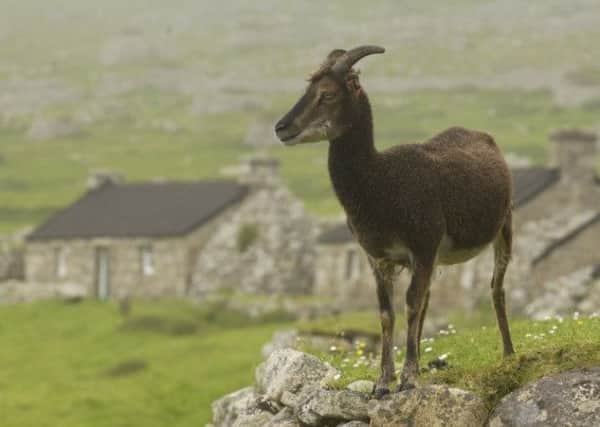Conference seeks to end Scots heritage rivalries


The National Trust for Scotland (NTS) is calling for the country’s most precious heritage to be given much greater protection and promotion.
NTS chief executive Kate Mavor told Scotland on Sunday that the organisation needed help to look after its assets, which include mansion houses, ancient landmarks, mountains, parks and gardens, nature reserves and islands.
Advertisement
Hide AdShe called for an end to heritage and cultural bodies working in “silos” and adopting a “protectionist” stance over assets, arguing instead for a “grown-up” conversation over how to safeguard landscapes, run down and neglected properties, art collections, and priceless artefacts.
She has spoken out days after NTS revealed it need to raise almost £50 million extra over the next decade to keep its properties up to scratch.
As Scotland’s biggest conservation charity, it is reliant on annual fees from its 320,000-strong membership and private donations to meet its £11.6m running costs, while Historic Scotland receives more than £40m in direct funding from the Scottish Government.
Mavor, who said the heritage sector was worth around £2 billion to the nation’s economy, said the creation of a new national collection would encourage different organisations to “pool” resources and pursue significant joint projects.
Relatively modern buildings of national significance, including concert and dance halls, theatres and cinemas, could be brought into the country’s care for the first time, organisations would be able to speak with one voice over contentious planning developments and joint campaigns to raise funds from the ex-pat community could be properly co-ordinated, it is thought.
Mavor warned that if organisations continued to compete for public funding and lottery cash in the face of the economic downturn and public spending cuts, they risked some hugely significant assets being overlooked, particularly those in private ownership or maintained by voluntary organisations.
Advertisement
Hide AdNTS was plunged into financial crisis five years ago, shortly after Mavor’s appointment, when it emerged its cash reserves had plummeted to less than £4m – almost £14m below where they should have been. A review of NTS found it was “living beyond its means” after agreeing to take on too many sites and properties.
It has since ranked all 130 of its main sites and properties in terms of their heritage significance and drawn up a ten-year plan to maintain them to a “gold standard”.
Advertisement
Hide AdPriorities for NTS over the next decade will be the islands of Iona, Staff, Canna and St Kilda; the battlefields at Bannockburn and Culloden; Culzean Castle, Ayrshire; Falkland Palace in Fife; Brodick Castle and its grounds on the island of Arran, and Newhailes house in East Lothian.
It is staging its conference in Edinburgh – titled Towards a National Collection? – months after expressing fears about a planned merger of Historic Scotland with the Royal Commission on the Ancient and Historical Monuments of Scotland, which will see a new body, Historic Environment Scotland, become a registered charity, effectively competing with NTS in future for funds.
Mavor said: “We’re starting to think about where the trust is going to be in ten, 20 and 30 years’ time. We know why we started off in the 1930s before there were any building listings and regulations, but what is our role now and what are we for? Are we for looking after everything we’ve got already or acquiring more things? Who is telling the story of the 20th century?
“We have a clear understanding of what it costs to run the organisation and are clear about what our priorities are. We want to confront the fact there are changes in the (heritage) marketplace and that there’s less money around. We want to start engaging with people as to what the solutions are.”
The Scottish Government, the Heritage Lottery Fund, English Heritage, Museums Galleries Scotland and Glasgow Life, which is responsible for the city’s cultural heritage collections, have all agreed to take part in next month’s conference at the Scottish National Gallery.
Mavor added: “We should make sure we’re not going head-to-head to try to get money for the same sorts of things and do it together – pooling our resources and making sure that they’re distributed around the whole country, rather than have one big project soaking it all up.
Advertisement
Hide Ad“We’re not saying: ‘here is the great solution’. With anything that is tricky, you get around the table and you talk about it. The whole point of this conference is to hear other perspectives.”
A spokesman for the Scottish Government said: “We welcome the initiative by the National Trust for Scotland in organising this conference to develop this important conversation. Government ministers have direct responsibility for many of Scotland’s iconic sites, as does the trust as a charity. There are also many thousands of owners who care for Scotland’s heritage, bringing a unique blend of skills, traditions and enthusiasm.”
National treasures
Advertisement
Hide AdCulzean Castle, Ayrshire: The 18th-century castle, designed by Robert Adam, is the former home of the Marquess of Ailsa, whose family donated it to the trust in 1945.
Culross, Fife: Reputed to have been founded by St Serf during the sixth century, the protected conservation village was a royal burgh, then a bustling port in the 16th and 17th centuries.
Ben Lomond: One of Scotland’s most popular peaks, it can be seen from the summit of Fort William, more than 70 miles away, on a good day.
Newhailes House, East Lothian: The 17th-century “neo-Palladian” villa which was built by architect James Smith, was rescued from a state of disrepair by NTS in 1997.
Iona: Known internationally as “the cradle of Christianity” thanks to the arrival of St Columba and his followers in AD563, its restored medieval abbey still holds daily services.
St Kilda: The isolated archipelago 41 miles west of Benbecula, has been uninhabited since 1930, but boasts one of the most important seabird breeding stations in Europe, as well as exceptional cliffs and sea stacks.